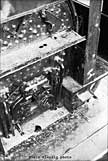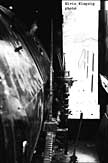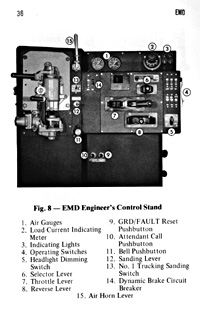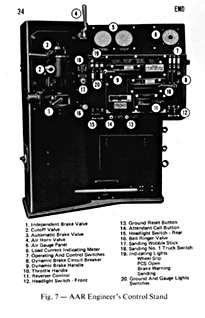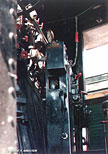This website has been archived from TrainWeb.org/screamingeagle to TrainWeb.US/screamingeagle.
|
|||||
| HOME Power Cabooses Rolling Stock MoW Depots | |||||
From Behind
the Throttle The
People There are two individuals who have contributed greatly to this project, who I'd like to personally thank - Bob Currie and Tuch Santucci. JD "Tuch" Santucci, a former MoPac Engineer, has generously allowed me to quote many of his stories and is a frequent poster at the MOPAC group on Yahoo and publisher of his own online newsletter, "Hot Times on the High Iron" -- it is always worth stopping whatever you're doing to read. Bob Currie, also a former MoPac Engineer that I've frequently corresponded with has built an excellent website filled with experiences of railroad life. Bob probably has more tales to share than he will ever get written down. The
Machines There's the sharp pitch of flange squeal that can rattle your teeth. There's soot and smoke and grease. There's hot steam, compressed air and the acrid fumes of diesel fuel being turned into power to pull a train a mile long. Being a member of the crew means that you understand this beast of burden as if it where a living, breathing animal. You know how to force this dangerous and stubborn beast to perform at your command. The
Stories We will continue to add more stories as told by former employees of the Missouri Pacific, material by engineers, and any interesting information we come across. Enjoy! Many of those who have contributed have their own excellent websites and organization -- we've provided links to some of these sites at the bottom - we highly recommend that you pay each a visit.
|
||||
|
From
Behind the Throttle While most didn't know it, MoPac was very quietly and conservatively one of the richest railroads in North America. It was indeed a great railroad. I was fortunate and got to operate all the new power as most of it was delivered to Yard Center and placed into service there. Favorites for road power were the SD40 series. In the yard the GP15 and MP 15 series and the GP38 series for much of everything else. I didn't care for the B23/30 series as their ride was extremely rough and would about kill your kidneys, although they did pull well on dry rail. The U30C's were bastard red-headed step children that were real oddballs and poorly maintained as a result. They seemed to be prone to failure. The GP50's were pretty good high speed units, but were poor performers on heavy tonnage trains. They tried them on some coal trains with dismal results including burning up main generators and traction motors. The GP15-1's actually had some remanufactured components. They required a trade in unit towards them. This lowered their purchase price and also offered the MoPac some tax breaks on the price of them as well. I liked them as they were really good units and performed well. Their only drawback was that some of them seemed to have excessive vibration when idling in regular idle.
|
|
The
DeQuincy Division - A View from the Driver's Seat The East Local ran
on the New Iberia Subdivision - formerly the New Iberia and Northern
Railroad - ran 48 miles from Port Barre to New Iberia, Louisiana. The
one local freight that ran over this track, #876, was the last regularly
scheduled timetable train on the Missouri Pacific. I loved this sub
more than any other. I was force-assigned to New Iberia, and I worked
my first job as an engineer on this sub. |
 |
| The
East Local
going by in July 1977. Bob's brakeman is bending down to pick up a rock
to throw - he was just water-ballooned by the East Local brakeman. - ©
Bob Currie Photo. |
| We had 4 jobs at
New Iberia: 2 salt dodgers, the East Local, and the Opelousas Turn. We
had 2 hand-cranked bridges over the Bayou Teche. One was just north of
New Iberia at Vida, and the other was at Oaklawn on the Franklin industrial
lead. Before I started working for the MOP, a locomotive went off into
the bayou at Oaklawn when the crew fell asleep approaching the bridge.
My occasional fireman on the Opelousas turn, Leroy Jackson, had the dubious
honor of riding that engine down into the cool, deep waters of the bayou.
Leroy told me that contrary to what you may think, GP7s do float for a
few seconds! NEW: Visit Bob Currie's NEW rail blog for his photos and many stories. |
| The Mississippi River
Bridge at Baton Rouge was part of the Beaumont Subdivision. The Beaumont
Sub ran from Houston's Settegast Yard to Anchorage Yard in Port Allen,
Louisiana. Anchorage Yard was located just at the base of the Mississippi
River Bridge at Baton Rouge. Many engineers had the advantage of being on what we called the Big MOP. My end of the line, the Gulf Coast Lines, usually got the older power. I was still running GP18s in the lead in the 80s.
Today Bob is
a Medical Technologist at Smith & White, and has currently completed
his first year Law school exam. Bob's old superintendent, C.E. "Cliff" Satterfield also has his own site - Missouri Pacific Railroad Memories. Cliff is a Missouri Pacific man from way back. Says Bob, "He helped make the Missouri Pacific one heck of a railroad." |
|
The Job Introductions are always first in order - here's a short description of the task assigned to each member of the crew. Engineer - Operates the train safely. The locomotive engineer was a hero throughout the west in earlier times. He was allowed to have his engine painted whatever colors he chose. He also had to work his way up, often starting years before as a Wiper in a yard house, then working his way up to Engine Watchman, to Switch-engine Fireman, to Road Fireman, to Hostler, then to Engineer. Conductor/Brakeman -The eyes and ears for the engineer during backward movements. Fireman - Help perform the daily startup/shutdown and inspection of the locomotive. Originally employed on steam locos to maintain steam pressure and assist the driver with the operation of the locomotive.ŹNow retained on some railways as the driver's assistant, particularly on longer distance or freight operations.
More terms: Bakehead - Nickname for the Fireman, because his head was so close to the fire box while he was shoveling coal. Door Slammer - What freight trainmen called passenger trainmen. Head Man - The freight train brakeman who rides in the locomotive cab. Hogger, Hog Head , Driver, "Big E" - The Engineer. Hogs, Lokies, Power, Motors - Locomotives Piglet - A locomotive engineer trainee.
In the days of steam, passenger and freight trains were operated by train crews, each consisting of at least four men: a conductor, a brakeman, a locomotive engineer and a fireman. The brakeman is the conductor's assistant, just as the fireman is the locomotive engineer's assistant. On many trains two or more brakemen are employed. When a baggageman is employed on a passenger train, he also is considered a member of the train crew. |
|
Practical
Jokes and Railroad Mayhem - "Porky"
and "Dilmer" The rail industry employs a diverse group of people from all sorts of backgrounds. As a result, we have quite the colorful bunch of players here who can really make the job interesting and fun. Back in my days at the MoPac, I fired on occasion for a fellow named Porky. His real name was Jim, but virtually nobody called him that. Porky was short and well, rather heavy. He could eat like there was no tomorrow. I watched him gnaw down some thirty pieces of chicken in a twelve-hour stint one evening. Porky had false teeth and never became accustomed to eating with them. He would take them out, drop them into his pocket and gum his food. It was quite the sight. We actually got along very well and I fired for him quite often. We would joke and laugh most of the night or day as the case might be. He was good with silly names and had one for almost everybody. I was working with him on the night transfer between Yard Center and the Belt Railway of Chicago's Clearing Yard. We had completed yarding our train upon our return to Yard Center and were now engine lite waiting at the signal at 162nd Street. This interlocking was located at the very south end of Yard Center. When we got this signal, we would be lined from the inbound runner to one of the main tracks and head up to the roundhouse to tie up the power. Our power this trip was pair of L&N GP9's. We were sitting on the south unit and the head man was on the north one. I could not see the signal from my vantage point as it was on the opposite side of the tracks and I had two units in the way preventing me from seeing it. We're sitting and patiently waiting for the signal when Porky calls out "Red." I started to release the brakes but then caught myself. "Red?" I said. "Ya, red. You shouldn't move." Ya, I guess I shouldn't. They don't call that signal "fire your ass red" for nothing. I made mention that it probably wasn't a real good idea to call out a signal like that while we are stopped at it. Being that we had put in a long night, somebody could easily go ahead and take off right by it. I managed to catch myself but under different circumstances. So Porky goes on to recount a story about just that. He told of sitting at a stop signal like this and calling out "Red" to his Fireman like he did with me. This Fireman immediately released the brakes, yanks back the throttle and quickly shoots right past the stop signal, only without permission to do so. Porky told of getting some discipline over this episode. Kinda makes me wonder why he pulled it with me. We had a Trainman there whom Porky dubbed "Dilmer." This guy at one point in his life was a bit overly fond of the drink. As a result, he contributed to the death of far too many brain cells. He wasn't quite the same in his later years. He was a character in his own right though. One day while working on the Chicago Heights Terminal Transfer in Chicago Heights (also known as the Hack Line), Dilmer decides to climb on top of a boxcar. This was a huge rule violation as by this point in time, we not allowed to be up on top of any car for any reason. Nonetheless, Dilmer gets on top. It had snowed quite a bit in recent days and there was a large pile of snow that had been plowed off the lead. This pile was at the very end of the lead and was right alongside the very boxcar on top of which Dilmer was standing. He looks down at the other guys on his crew and says "Shoot me" "What?" "Shoot me! You know, like in the movies. Pretend you have a gun and shoot me." So the Duke of Earl who was working with him makes the always popular thumb and index finger gun we all made as kids, points it at Dilmer and goes "BANG!" Dilmer yells out "Oh they got me" grabbing his chest and proceeding to fall off the car and into the pile of snow, just like in the movies. However in the movies it is normally a professional stuntman performing this feat of acrobatics. Needless to say, nobody believed what Dilmer just did and went running up to see if he was alright. He was and was laughing about this whole episode. When it was mentioned to him that this pile of snow might have been frozen solid or perhaps maybe just a little bit of snow pushed up on top of a pile of ballast and he could have been seriously injured, Dilmer just shrugged and said "Oh, I guess I never thought of that." |
|
Practical
Jokes and Railroad Mayhem - Watch
out for the Wolves When I first went on the road in 1984, I fired for an Engineer named Bill Daly. Billy was quite the character. He always used to tell me to "Watch out for all those wolves out there." I would soon learn what this meant. One early morning we were coming south on train CDZ (Chicago to Dallas Expedited). I was running and had them rolling along at a pretty good pace. It was a very cold and snowy night and had reached that "late night side of early morning" point in time where the body is demanding to go to sleep. I was slouched low in the seat with one hand hanging off the handle of the automatic brake valve and deep in contemplation about where I was going to begin my slow down for a temporary speed restriction coming up. I was going to have to reduce from our speed of 60 mph down to 25 mph. Billy and head man Marvin Klinemeyer were on the Fireman's side and both were very quiet. I was thinking that maybe they were both in the grasp of Morpheus. I did hear a little stirring, but no sounds of consciousness. As I am deep in thought about my slow down, I really gave it little thought. All of a sudden with out warning, there is the loud scream of "WAAAAAAA!!!!!!!" to my left. Simultaneously my arm gets grabbed and pulled towards the left side of the cab. The very same arm that had the grip on the automatic brake valve handle. I just about jumped through the closed window on our lead GP50 locomotive. Then I hear all sorts of laughter from both Billy and Marvin. It was then that I learned what those "wolves" Billy always mentioned were all about. He proceeded to tell me he pulled this stunt on about every Fireman he had over the years. He explained the grabbing and pulling of my arm towards the left side of the cab and how this came to be. It seems that one night he pulled this stunt on one particular Fireman, but didn't grab hold of his arm. Not only did the Fireman jump and cry out in shock, he also grabbed the automatic brake valve handle and proceeded to pull it and put the train into emergency. The story goes that they got two knuckles as a result of the emergency application. They had to concoct a story to give to the Dispatcher about what caused the emergency application. They blamed it on a hose separation and nothing further was mentioned of the event. After this little disaster, Billy decided it would be a good idea to grab hold of the Fireman's arm to prevent this from happening in the future. Instead of a train separation, just maybe a little laundry cleaning would be in order. |
|
Rail
Terms and Slanguage Names for the caboose included hack and crummy. The switchman (or
head brakeman on road trains) that pulled the pins during switching operations
was called the pin man. If a crew kicked cars during switching operations, that was called "flat switching". If cars were shoved over a mound (hump) and the cars rolled down into tracks under their own momentum, that was called hump switching. Another name for train orders was "flimsies." A yard clerk was called a mud hop (I started my railroad career as a mud hop). On a freight train, the conductor is in charge of the work on the ground. On a switch engine, the footboard yardmaster is in charge of the work on the ground. Powerbraking - The Missouri Pacific did not have dynamic brakes on its engines. The MOP was a powerbraking railroad. The engineer kept a steady hard pull on the train with his engine, often leaving the engine in run 8 almost to a stop. If you had a train running 50 mph, if the throttle was not in run 8, you put it in run 8, and then about 1.5 to 1.25 miles from where you wanted to stop you made a 6-pound reduction of the train line. The MOP carried an 80-pound trainline on its freight trains. Some railroads carried the minimum 70 pounds, while many carried the maximum 90-pound trainline. A 6-pound reduction made with the automatic brake valve (keeping the engine brakes released) caused the car brake valves to put 15 pounds of pressure into each car brake cylinder. Each additional pound of trainline reduction put 2.5 pounds of pressure into the car brakecylinders. After making the initial reduction of 6-8 pounds, we followed with 2-pound reductions. Often, a 6-2-2 combination was sufficient to stop a 100-car train in 1.25 miles, even with the engine pulling hard to keep the train stretched. We had a saying for when we got a knuckle- "I got 6, 2, and 2, and when I stopped I was in two." I told that to the road foreman of engines on the occassion of my getting 2 knuckes at once, and he made me drive 150 miles to Baton Rouge to discuss it after I tied up. The advantage of power braking was that it was very smooth for the people riding the caboose- no slack action. Also, when we started the train moving, you could put the engine in a much higher throttle position, say run 4, because as soon as the engine moved, the caboose moved. I have had a train so tight that my engine moved only 1 foot and the conductor said "all moving." With the new EMD power (GP35s, GP38s, and SD40s), you could start a train without having to take slack. On a long, heavy train with the GP7s and GP9s, and sometimes with the GP18s, you may have to take slack to get the train moving. When taking slack, you either took just a little (4 or 5 cars), or you took slack on the whole train. This was so prescribed in the Air Brake and Train Handling Instructions, and was on the engineer's exam. Wheel slip was an engineer's worst nightmare when starting a train. If the wheel slipped and then grabbed, the train would be yanked in two if you were not quick on reducing the throttle. We always stopped the engine on sand (except within interlocking limits) so that we would have some good traction when starting.
A-unit - a normal locomotive that has a control stand (different than a B-unit). Normally only used to differentiate a locomotive from a B-unit where they may share a similar body or engine. F7 locomotives were made in both A-unit and B-unit styles, for example. Anti-climber - ridge on the front of a locomotive so that in case of a collision with another vehicle, it doesn't ride up into the locomotive cab B-unit - locomotive which has a diesel engine and generator but no cab. Covered Wagon - a cab unit, or more generally, a fully cowled locomotive. Cowl - the covering over the working parts of the locomotive. A fully-cowled locomotive has no walkways on the outside; the long hood extends straight back from the cab. CTC - centralized traffic control. This is a system of track control where an RTC controls the signals and switches along the track and thus controls the trains on it. Belt Line - A railroad with trackage within and/or around a city, operating as a pickup, delivery and transfer facility for truck lines and industrial plants. Block System - A system of railroad tracks divided into short sections or blocks, usually three or four miles in length, which will permit trains to be run by signal apparatus so that no train can enter a block until the preceding train has left it. Branch
Line - A line serving one or more stations beyond the point of junction
with the main or another branch line. Chain Gang - When a number of extra trains (not regularly scheduled freight runs) are put into service, regular crews may be assigned to take such trains in turn. When this occurs, train crews are said to be operating in chain gang service. Dead Head / Dead Heading - A railroad employee traveling as a passenger. The employee performs no service in such travel status, and he/she is paid for his/her time while in travel at an hourly "dead head" rate. Dog chasing - A crew change out. Double the hill - the train is split in half to get up a grade. Double Track - Two main tracks, one of which the trains run in one direction and the other in the opposite direction. Drag - Describes the movement of a heavy train, such as a coal drag Dump the air - Emergency application of the air brakes causing a train to stop abruptly Extra Board - A list of employees who may be assigned to train crews (1) when extra trains are run, (2) when regular crews have not had sufficient rest time before they can legally be required to return to duty, or (3) when relief men are required on regular crews. Foamers - people who gathered along the tracks to watch trains. Gauntlet - A third set of rails placed in between two other sets of rails to carry wide loads through tunnels. Grip
- Trainman's suitcase
Highballing - Running at maximum permissible speed Hole - Side track on a single track line which permits another train to pass. Interchange - to move a rail car or locomotive from one railway to another. This usally takes place at an "interchange point". Ladder track - series of turnouts leading to parallel tracks Livery - paint scheme, manner in which equipment is painted (e.g. stripes, bars, colours, logos), usually for a locomotive Mainline - a.k.a main, iron, high iron, high rail Mosey Speed - means when you approach the limit of your track warrant and have not received a new warrant, you mosey up to the limit prepared to stop. MU - multiple unit; slaving of two or more diesel electric locomotives together, controled from the control stand of only one of them, usually the lead locomotive. No Bill - A worker who refuses to join the union, particularly train or enginemen. Pig train - intermodal train, originally piggyback Piggyback - occurs when a tractor trailer is placed (usually without the tractor) on a flat car or specially-designed rail car. See also TOFC. Prime mover - drives a generator which produces electrical power to drive the traction motors. There is usually one traction motor on each axle. Pull the pin - uncouple Put it on the ground - the train has derailed Pusher
-
a locomotive built to help trains up steep grades by pushing from behind Ran a Red Block - Enter a circuit without clearance from the control tower. Red Ball - A fast freight train. Siding - An auxiliary track along the main line which is used to permit other trains to pass. (See Hole.) Spark arrester (arrestor) - device on the exhaust of a locomotive to keep sparks from flying out and starting fires. These are often quite distinctive on MP equipment. Spot - park a rail car. Steam generator - equipment to generate steam to heat passenger cars in the early age of diesel. Some diesel locomotives have steam generators in them; steam was passed to the attached passenger cars by interconnected pipes. TOFC - short for Trailer On Flat Car; when a tractor trailer is placed (usually without the tractor) on a flat car or specially-designed rail car. Trick - A work shift or hours of duty. Turn-Around - A train run from a terminal to an intermediate station and return to that terminal in one work shift. Varnish - private railroad passenger car, a.k.a "private varnish" Winterization Hatch - baffle placed over the radiator fan on some locomotives used in colder climates to retain heat in the locomotive Throw it in the hole - Apply emergency brakes. On the high iron, let the big dogs walk - the caboose is over the switch and on the mainline so open the throttle all the way on the locomotives All black, well stacked, goin' down the track clickity clack - the train looked good on the visual roll-by inspection.
Related Links:
|
Controlling One-Thousand Horses An engineer may work
daytime or night -- the railroad never sleeps. |
|
Practical
Jokes and Railroad Mayhem - Just Looking
for the Tosh Another character at the MoPac was known as "The Tosh." This was a play on his last name. He seemed to have a few screws that had come loose. Well actually they fell completely out over the years and rolled away. He was about half goofy. He did all sorts of outlandish things on duty. After going out drinking with him one evening after work, I learned that he was the same way outside the railroad too. I also quickly learned that one should never go out drinking with him either. I didn't think I was going to make it home alive.
While working a night switcher in 8 Yard at Yard Center with Tosh one evening, we had to switch out some retired Seaboard Coast Line locomotives. They were enroute to Pielet Bros. Scrap yard in McCook, IL. Now we never, under any circumstances, to allow locomotives dead or alive to roll free. Rules are made to be broken, right? I can see one of these locomotives in the cut from my vantage point and see that it is next out to be switched. Tosh gives me a kick sign. WHAT? I didn't move. Again he gives the kick sign, only with even more emphasis than normal. I wind them up, the Headman pulls the pin, Tosh gives me the stop signal and I grind them down to a stop. This old locomotive takes off down the lead and zooms into track 14. I could hear the crash in my engine as the old locomotive clobbered the cars already in the track. While nothing derailed, the car the locomotive hit was damaged. We never even filled out wreck reports over the situation. One evening Tosh has to swing a cut of cars over from TwoYard to Nine Yard at Yard Center. This required a long shove and part of that shove involved a couple of road crossings. As fate would have it, the rear car was a load of farm tractors. This car would be leading the movement as they shoved south across the interlocking at 144th Street and over the two road crossings involved. Tosh, deciding he really needed to light things up in the darkness of the late evening resorts to extraordinary measures. He proceeds to turn on all the lights on all the tractors loaded on this flatcar. He then lit two fussees placing them on the very south end of the car and when they got the signal, instructed the Engineer to start shoving the cut south. We were pulling out of the north end of a track in One Yard and were able to observe this first hand. Here comes the cut across 144th Street with two fussees glowing in their pinkish flame, all the headlights and tail lights illuminated on every tractor on the car, and Tosh sitting in the seat of the very south tractor. He looked like King Farook. It was quite the sight to behold. As he passed us, he casually waved as if this was something he did on a daily basis. We were laughing our heads off. |
|
Practical
Jokes and Railroad Mayhem - Company
Phone Calls to Hawaii And yet another character on the MoPac was a Trainman named Marshall. He was right ahead of me in seniority on the Trainman's list. Being that our Trainman's extra board was a seniority board, this was actually to my advantage. He was notorious for taking calls, then either marking off at the last minute or not showing up and then calling in saying he couldn't make it. This would give me a late call to work his assignment. It also meant I got paid from when the job went on duty, no matter what time I arrived. On one occasion he even called in late and told the Caller he was in jail. They checked it out and found out he really was too. It was unfortunate that he wasn't kept there. This guy had a girlfriend who was on vacation in Hawaii. While she was gone, he had landed the afternoon switcher at 26th Street Yard in Chicago Heights. Every afternoon he would arrive a few minutes early and call her in Hawaii from a company phone at the 26th Street Yard office. When the job went to coffee, again he would call her in Hawaii. This was also the case for lunch break and then when the job tied up. He did this for a good week. Sometime later when the phone bill arrived, those in charge about had a stroke. Here were dozens of calls to Hawaii. It is highly unlikely the MoPac would have any reason to transact business between their 26th Street Yard and the 50th state. It was a good bet the powers that be would begin to investigate this bill rather thoroughly. And they did. It took them a few weeks, but they were able to use the process of elimination to nail Marshall as the culprit of these phone calls. He was made to reimburse the company for all the calls, over $300 worth. |
| New
Power on the MOP "Tuch" Santucci Between the mid 70's and until 1984, all new MoPac power purchased from both builders (EMD and GE) was always delivered dead to Yard Center and placed into service there. Reps from both EMD and GE would come in and do all the necessary checks and tests with Yard Center Diesel personnel to get them operational. All new power would work south out of Chicago to North Little Rock or St Louis (for GE units up to, but not including the B30-7A's) where finishing touches would be added. MoPac did not have radios, refrigerators, and a few other items installed on most new power at the manufacturers. The lack of such items restricted these units to trailing unit status only on their maiden voyages. The 1300 series MP15DC switchers were an exception. They had radios and refrigerators on them and several were not only placed into service at Yard Center, but also assigned there for duty. I had the good fortune of being the first Engineer to use the 1357 and 1362 after they were released for service in 1982. |
|
Reportedly seen bustling around North Little Rock in the late '70's and early '80's, a GP7 with Mighty Mouse on it's side has the distinction of having it's own mascot. MoPac railcrews had their share of practical jokers, and one such joker applied the cartoon to the long hood of MP #180. |
|
Horns
& Whistles The
50 Rock Island GP38-2's acquired from the Rock estate all had the Nathan
five chime horns. All still had them intact when I left the MoPac in 1985. |
|
Inside the Cab and other Views Missouri Pacific locomotive cab interiors - both steam and diesel. The first two shots of steamer #2522 show the engines's firebox, guages, brakes, and the long Johnson bar. The second interior is from an EMD SD40 2 cab, MP #6044, showing the control stand (for a comparison, see view of a 40-2 unit owned by BN, shown in the next group below).
For more details on locomotive operation, view the Operators Manuals: |
|
Cab Views from Other Roads Though not Missouri Pacific units, we've included these below photos since they may be of interest to the readers of this page - and demonstrate the ever changing world of the Engineer. |
||||||
|
More Railroad Stories In Bob Currie's own words, he is an "A-1" practical joker. You'll enjoy the humorous side of his true stories featured on his website: |
|
Railroad Employees Occasionally we receive some great remarks about fellow employees. We've listed some of their names here for the interest of former co-workers: "... a great hogger, Irv Pupkes. He farms around Falls City, Nebraska and has a step-son, Bob Prichard, who was a Conductor. Both were a couple of the nicest people I've met. And Irv could really handle a train." (James Blagg) |
![]()
This Site is Dedicated to those who ran the MoPac
and made her one of the greatest roads in the Nation.
|
MPRR Employee Feature Pages
- Input from all former-MPRR Employees welcome!
|
||||
Special Thanks to All the Former Missouri Pacific RR
Engineers and Employees
who have contributed their lives to the Railroad and their unique knowledge
to this site:
James Blagg MPRR Telegrapher-clerk, Concordia and Omaha Sub's, 1973-1987
Bob Currie MPRR Engineer DeQuincy Division, 1972-1990 (engineer 1973-1990)
Daryl W. Favignano MPRR Mechanical Engineering Dept. at St Louis, 1974-1986
Jay Glenewinkel MPRR/UPRR Crew Van Driver, 1992-1997
Nathan Griffin MPRR/UPRR, Hoskins Junction, Clute, Texas, 1975-Today
JD "Tuch" Santucci MPRR Engineer, Dolton and Villa Grove, IL , 1978-1985
Recommended Websites operated by former MPRR Employees:
Bob
Currie's NEW rail blog -
MP Engineer
Hot Times
on the High Iron by "Tuch" Santucci - MP Engineer
Missouri
Pacific Railroad Memories by C.E. "Cliff" Satterfield - MP Superintendent
B.M.W.E.
Union, Lodge # 0455/Missouri Pacific System Federation
|
MPRR Employees Service Forum
- Devoted to sharing information of former MoPac employees. Feel
free to post names or information of those who worked on the railroad
-- former MP Employees are Welcome! |
Help Save Lives
Operation
Lifesaver
|
trainweb.us/screamingeagle l Last Update
to this page: 16 April, 2008
|
|
| All images & text © 2000-2008 T. Greuter / Screaming Eagles, unless otherwise noted. All Rights Reserved. | |
















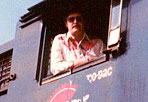
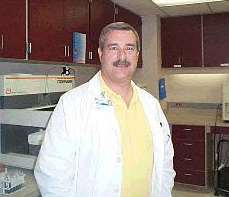

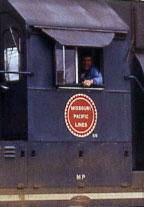
 He
said and did all sorts of insane and goofy things. A fellow employee had
a great deal of fun with his nickname and applied it to the "Kilroy was
here" drawing of the guy with the large proboscis looking over the fence.
He drew this picture and wrote "Just looking for the Tosh". He drew it
on almost everything: walls, rolling stock, in the dirt on the side of
company vehicles. I once saw it on the side of a Carmen's shanty in Fort
Worth, TX while riding Amtrak. The Tosh was now universal.
He
said and did all sorts of insane and goofy things. A fellow employee had
a great deal of fun with his nickname and applied it to the "Kilroy was
here" drawing of the guy with the large proboscis looking over the fence.
He drew this picture and wrote "Just looking for the Tosh". He drew it
on almost everything: walls, rolling stock, in the dirt on the side of
company vehicles. I once saw it on the side of a Carmen's shanty in Fort
Worth, TX while riding Amtrak. The Tosh was now universal. "I
am here to save the day"
"I
am here to save the day" 